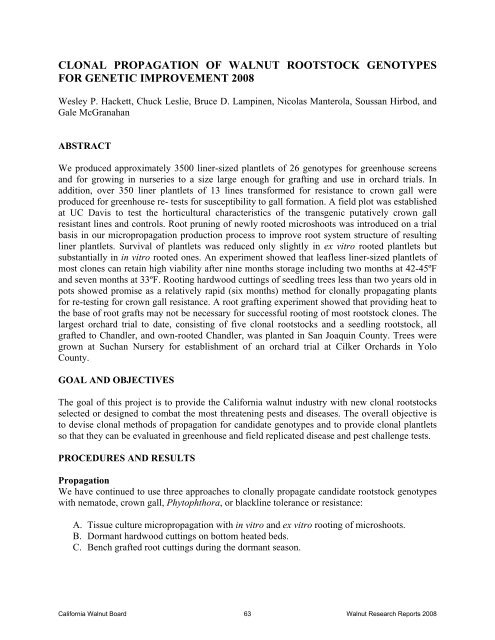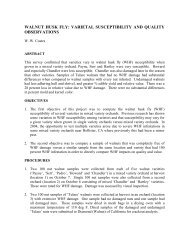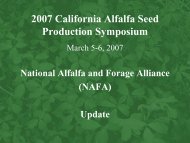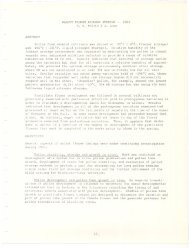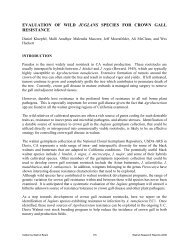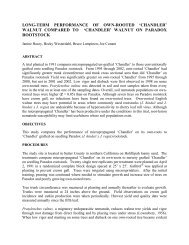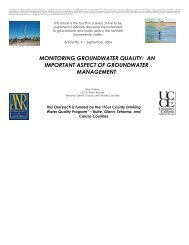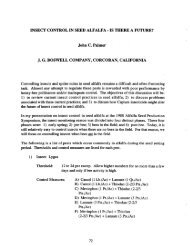clonal propagation of walnut rootstock genotypes for genetic ...
clonal propagation of walnut rootstock genotypes for genetic ...
clonal propagation of walnut rootstock genotypes for genetic ...
You also want an ePaper? Increase the reach of your titles
YUMPU automatically turns print PDFs into web optimized ePapers that Google loves.
CLONAL PROPAGATION OF WALNUT ROOTSTOCK GENOTYPESFOR GENETIC IMPROVEMENT 2008Wesley P. Hackett, Chuck Leslie, Bruce D. Lampinen, Nicolas Manterola, Soussan Hirbod, andGale McGranahanABSTRACTWe produced approximately 3500 liner-sized plantlets <strong>of</strong> 26 <strong>genotypes</strong> <strong>for</strong> greenhouse screensand <strong>for</strong> growing in nurseries to a size large enough <strong>for</strong> grafting and use in orchard trials. Inaddition, over 350 liner plantlets <strong>of</strong> 13 lines trans<strong>for</strong>med <strong>for</strong> resistance to crown gall wereproduced <strong>for</strong> greenhouse re- tests <strong>for</strong> susceptibility to gall <strong>for</strong>mation. A field plot was establishedat UC Davis to test the horticultural characteristics <strong>of</strong> the transgenic putatively crown gallresistant lines and controls. Root pruning <strong>of</strong> newly rooted microshoots was introduced on a trialbasis in our micro<strong>propagation</strong> production process to improve root system structure <strong>of</strong> resultingliner plantlets. Survival <strong>of</strong> plantlets was reduced only slightly in ex vitro rooted plantlets butsubstantially in in vitro rooted ones. An experiment showed that leafless liner-sized plantlets <strong>of</strong>most clones can retain high viability after nine months storage including two months at 42-45ºFand seven months at 33ºF. Rooting hardwood cuttings <strong>of</strong> seedling trees less than two years old inpots showed promise as a relatively rapid (six months) method <strong>for</strong> <strong>clonal</strong>ly propagating plants<strong>for</strong> re-testing <strong>for</strong> crown gall resistance. A root grafting experiment showed that providing heat tothe base <strong>of</strong> root grafts may not be necessary <strong>for</strong> successful rooting <strong>of</strong> most <strong>rootstock</strong> clones. Thelargest orchard trial to date, consisting <strong>of</strong> five <strong>clonal</strong> <strong>rootstock</strong>s and a seedling <strong>rootstock</strong>, allgrafted to Chandler, and own-rooted Chandler, was planted in San Joaquin County. Trees weregrown at Suchan Nursery <strong>for</strong> establishment <strong>of</strong> an orchard trial at Cilker Orchards in YoloCounty.GOAL AND OBJECTIVESThe goal <strong>of</strong> this project is to provide the Cali<strong>for</strong>nia <strong>walnut</strong> industry with new <strong>clonal</strong> <strong>rootstock</strong>sselected or designed to combat the most threatening pests and diseases. The overall objective isto devise <strong>clonal</strong> methods <strong>of</strong> <strong>propagation</strong> <strong>for</strong> candidate <strong>genotypes</strong> and to provide <strong>clonal</strong> plantletsso that they can be evaluated in greenhouse and field replicated disease and pest challenge tests.PROCEDURES AND RESULTSPropagationWe have continued to use three approaches to <strong>clonal</strong>ly propagate candidate <strong>rootstock</strong> <strong>genotypes</strong>with nematode, crown gall, Phytophthora, or blackline tolerance or resistance:A. Tissue culture micro<strong>propagation</strong> with in vitro and ex vitro rooting <strong>of</strong> microshoots.B. Dormant hardwood cuttings on bottom heated beds.C. Bench grafted root cuttings during the dormant season.Cali<strong>for</strong>nia Walnut Board 63 Walnut Research Reports 2008
Tissue culture micro<strong>propagation</strong>: We produced approximately 3500 liner plantlets <strong>of</strong> 26<strong>genotypes</strong> <strong>for</strong> replicated disease and pest screening tests by Greg Browne, Dan Kluepfel andMike McKenry and <strong>for</strong> growth and grafting in nurseries <strong>for</strong> subsequent orchard trials (Table 1).We also produced about 350 liner plantlets <strong>of</strong> 13 lines trans<strong>for</strong>med <strong>for</strong> putative resistance tocrown gall plus non-trans<strong>for</strong>med control lines <strong>for</strong> use in greenhouse screening re-tests <strong>for</strong> crowngall resistance by Dan Kluepfel (Table 1). This past year’s production, plus hold-over plantletsfrom the previous year’s production, gives us an inventory <strong>of</strong> about 5000 liner plantlets ready <strong>for</strong>immediate use in replicated disease and pest resistance re-tests and in nursery row growth andgrafting <strong>for</strong> orchard trials (Table 2). Based on an experiment we reported in 2007 which showedimproved root structure <strong>of</strong> liner plantlets that had been severely root pruned at the time <strong>of</strong>planting in liners, we introduced root pruning into our production process on a trial basis. Table 3shows that root pruning at the time <strong>of</strong> planting reduced survival <strong>of</strong> both ex vitro and in vitrorooted plantlets. The reduction in survival was quite small (68 to 63%) <strong>for</strong> ex vitro rootedplantlets but larger (71 to 51 %) <strong>for</strong> in vitro rooted plantlets. We don’t have an explanation <strong>for</strong>why survival was reduced more by root pruning <strong>of</strong> in vitro, as compared to ex vitro, rootedplantlets. Based on these results we will continue root pruning as a standard practice but also tryto figure out why root pruning may reduce survival more <strong>for</strong> in vitro than ex vitro rootedplantlets.Cold storage <strong>of</strong> liner size plantlets derived from micro<strong>propagation</strong> is advantageous <strong>for</strong> at leastthree reasons: 1) storage conserves greenhouse bench space 2) storage at temperatures <strong>of</strong> 42-45ºFprovides the chilling necessary <strong>for</strong> maximum growth potential when plantlets are planted in thenursery row or orchard site 3) storage allows year-around laboratory production while permittingchoice <strong>of</strong> the most desirable time <strong>for</strong> nursery row or orchard planting.The length <strong>of</strong> time plants can be stored has been restricted because plantlets stored attemperatures around 42-45ºF begin to grow after about five months. Because storage occurs withonly very low light, the shoots that <strong>for</strong>m are etiolated and the growth depletes the stored nutrientsrequired <strong>for</strong> nursery or orchard establishment and growth. In an ef<strong>for</strong>t to extend the length <strong>of</strong>storage time possible without shoot growth, we per<strong>for</strong>med an experiment using a lower storagetemperature (33ºF). After an initial eight week storage period at 42-45ºF with short days and lowlight to cause leaf abscission and to put the plants in a dormant condition, the plantlets weretransferred to a cold room with no light at 33ºF. Plants were then transferred to greenhouseconditions after five, seven and 10 months storage at 33ºF to assess survival and growth. Table 4shows that the survival <strong>of</strong> nine different clones was very high overall after five and seven months<strong>of</strong> storage (89 and 87%, respectively) at 33ºF but dropped <strong>of</strong>f markedly to 35% after 10 monthsstorage. Two clones (Burbank and UX2) appeared to be losing some viability after storage <strong>for</strong>seven months as their survival in the greenhouse had dropped <strong>of</strong>f to 60 and 40 % respectively,whereas the other clones still had survivals <strong>of</strong> 80 to 100%. These results indicate that leaflessliner-size plantlets <strong>of</strong> most clones can retain high viability after nine months <strong>of</strong> storage, includingtwo months at 42-45ºF and seven months at 33ºF. The reason that plantlets lost viability afternine months is not known but it could be due to desiccation <strong>of</strong> the leafless shoots, since thehumidity at 33ºF is quite low. We are currently doing an experiment to see if we can reduce loss<strong>of</strong> viability at 33ºF by storing the plantlets inside plastic garbage bags to reduce water loss anddesiccation.Cali<strong>for</strong>nia Walnut Board 64 Walnut Research Reports 2008
Liner plantlets from cold storage were re-potted into avocado pots (1½ gallon) and then grown inthe greenhouse to provide actively growing 3/8-1/2 inch diameter trees <strong>for</strong> use in screens <strong>for</strong>crown gall resistance by Dan Kluepfel. Forty five plants <strong>of</strong> seven transgenic lines that had showncrown gall resistance in previous screens and control plants were provided. Thirty plants each <strong>of</strong>AZ025, RX1, Vlach and VX211 were also provided <strong>for</strong> an inoculation dosage test along with120 AX1, 80 AX2 and 35 AX3 plants <strong>for</strong> experiments on methods <strong>of</strong> wounding and inoculation<strong>for</strong> improved crown gall screens. These plants were grown and screening tests were per<strong>for</strong>med ina Plant Science greenhouse specifically managed <strong>for</strong> crown gall screening. Liner plants were alsogrown on to a size large enough <strong>for</strong> Phytophthora screening. A total <strong>of</strong> 670 plantlets <strong>of</strong> 17<strong>genotypes</strong> from cold storage were re-potted in Cetap 1½ liter pots and grown further in thegreenhouse to provide actively growing 1/4-3/8 inch diameter trees <strong>for</strong> use in screens <strong>for</strong>Phytophthora citricola and P. cinnamomi resistance. Screens were per<strong>for</strong>med by Greg Browne ina USDA greenhouse.Fully chilled liner plantlets <strong>of</strong> 10 clones (16 to 36 plants each) were used in a nursery experimentto test the effect <strong>of</strong> root pruning on the quality <strong>of</strong> root systems produced in the nursery row.Plantlets from 1½” diameter x 7” deep Tree Tubes were planted in a nursery row in May withroot systems intact or the lower 2/3 <strong>of</strong> the root balls pruned away. Resulting trees will be graftedwith Chandler in 2009 and dug in 2010 at which time the quality <strong>of</strong> root systems will beevaluated.Hardwood cuttings: Hardwood cutting material <strong>of</strong> RX032, Juglans cathayensis #21 and UZ229from the original mother trees at Kearney Research and Extension Center was received fromMike McKenry in mid-January 2008. Because these trees had not been pruned to stimulatevigorous shoot growth, the material did not yield many cuttings <strong>of</strong> the quality that have the bestchance <strong>of</strong> rooting. In addition we collected cutting material from the J. cathayensis #21 mothertreeat the Wolfskill Experimental Orchard. Hardwood cuttings <strong>of</strong> all four <strong>genotypes</strong> were made,treated basally with 8000 mg/l potassium indole butyric acid and placed on a bottom-heating bedat 27C. About 25% <strong>of</strong> the cuttings <strong>of</strong> J. cathayensis #21 and UZ229 rooted but none <strong>of</strong> theRX032 or J. cathayensis mother tree rooted. We were able to provide Mike McKenry with fiverooted-cutting trees <strong>of</strong> J cathayensis #21 and 10 rooted-cutting trees <strong>of</strong> UZ229 <strong>for</strong> a nematoderesistance trial at Kearney. Subsequently the mother trees at Kearney were pruned so that morehigh quality cutting material will be available in 2009.Hardwood cuttings were also used to <strong>clonal</strong>ly propagate <strong>for</strong> re-testing 95 open pollinatedseedlings from mother trees representing nine species from the National Clonal Repository thathad no galls or small gall <strong>for</strong>mation 15 months (two growing seasons) after inoculation with avirulent strain <strong>of</strong> Agrobacterium tumefaciens. A total <strong>of</strong> about 300 cuttings were made in earlyFebruary and treated as described above. A total <strong>of</strong> 89 rooted cuttings were grown on in avocadopots <strong>for</strong> re-testing by Dan Kluepfel’s laboratory. Rooting <strong>of</strong> cuttings from seedling trees in potsless than two years old shows promise <strong>for</strong> a relatively rapid (six months) method <strong>for</strong> <strong>clonal</strong>lypropagating plants <strong>for</strong> re-testing <strong>for</strong> crown gall resistance. Use <strong>of</strong> hardwood cuttings reduces thenumber <strong>of</strong> <strong>genotypes</strong> that need to be propagated by in vitro micro<strong>propagation</strong> which is initiallyslow to produce plantlets and labor and resource intensive.Cali<strong>for</strong>nia Walnut Board 65 Walnut Research Reports 2008
Bench grafting root cuttings: A small root-grafting experiment was per<strong>for</strong>med to comparerooting <strong>of</strong> root pieces when the temperature was kept at 78ºF at either the graft union only or atboth the graft union and the base <strong>of</strong> the root piece. As shown in Table 5, rooting was as good orbetter <strong>for</strong> three <strong>of</strong> four clones tested when heat was provided at the graft union only. WithAZ025, a sparse rooting clone, providing heat to the base did improve rooting somewhat. It maybe that the heating cable at the graft union provides a temperature at the base, even thoughprobably lower than that at the graft union, high enough to promote rooting. This suggests thatthe optimum temperature <strong>for</strong> rooting may be lower than that <strong>for</strong> graft union healing (however, notemperature measurements have been made to confirm this). These results do indicate thatproviding heat to the base <strong>of</strong> root grafts may not be necessary <strong>for</strong> successful rooting <strong>of</strong> mostclones and may even be detrimental.Due to concern that the root pieces used to make root grafts have been in contact with field soiland that the wounding necessary to the process could increase the incidence <strong>of</strong> crown gall on theresulting nursery trees, we evaluated 129 root grafted trees after two years in the nursery row.Seven <strong>of</strong> the 129 trees had galls (5.4%) at the site <strong>of</strong> the graft union. This is a very highincidence <strong>of</strong> crown gall and may indicate that root grafting can exacerbate nursery problems withcrown gall. However, <strong>of</strong> the six <strong>rootstock</strong> clones used <strong>for</strong> the root grafts, WIP3 trees had five <strong>of</strong>the seven galls detected. The frequency <strong>of</strong> galls on WIP3 trees was 36%. The frequency on theother five clones was 1.8% which is still quite high. The high incidence <strong>for</strong> WIP3 trees is basedon a small sample but other data based on inoculation <strong>of</strong> WIP3 trees with a virulent strain <strong>of</strong> A.tumefaciens also indicate that it is quite susceptible to crown gall <strong>for</strong>mation.Field Trials: Currently established <strong>clonal</strong> <strong>rootstock</strong> field trials are summarized in Table 6.Fully chilled liner plantlets (100 each) <strong>of</strong> Vlach, VX211, RX1 and Burbank were provided toSuchan Nursery <strong>for</strong> growing to sufficient size <strong>for</strong> planting as dormant bare-root trees in anorchard trial to be established at Cilker Orchards in Yolo County in 2009 and grafted withHoward scions.The largest orchard trial <strong>of</strong> <strong>clonal</strong> <strong>rootstock</strong>s to date was planted this year in San Joaquin Countyunder the direction <strong>of</strong> Joe Grant. Chandler-grafted nursery trees using five <strong>rootstock</strong> clones andseedling paradox were dug in January 2008 and planted along with own-rooted Chandlers.A one acre field plot at UC Davis was planted with transgenic, putatively crown gall resistantlines and controls <strong>for</strong> assessment <strong>of</strong> horticultural characteristics.Nursery Propagation and Commercialization: We are prepared to provide cultures <strong>of</strong>microshoots to any laboratory or nursery that wants them <strong>for</strong> licensed production <strong>of</strong> plants. Wecan also provide microshoots <strong>of</strong> Vlach, a public domain clone, to any laboratory or nursery thatwants to produce it. The appendix includes a list <strong>of</strong> laboratories presently licensed <strong>for</strong> in vitroproduction <strong>of</strong> <strong>clonal</strong> <strong>rootstock</strong> selections and sale <strong>of</strong> <strong>clonal</strong> <strong>rootstock</strong> plantlets as liners <strong>for</strong>nursery or orchard planting.Cali<strong>for</strong>nia Walnut Board 66 Walnut Research Reports 2008
Table 1. Greenhouse survival <strong>of</strong> rooted <strong>clonal</strong> microshoots# Alive # Total % SurvivalParadoxAX1 544 700 78AX2 18 22 82AX3 21 29 72Burbank 40 67 60DAR 174 309 56GZ2 6 11 55GZ3 164 227 72JX1 24 54 44MW1 42 113 37Px1 54 76 71RX1 713 1105 65UX1 27 78 35UX2 23 36 64UZ 229 198 367 54UZ1 50 75 67UZ2 21 46 46Vlach 145 282 51VX211 525 733 72XZ1 10 19 532799 4349 64.4%CLRV TolerantWIP2 95 284 33WIP3 407 806 50WIP4 81 197 41WIP6 76 230 33659 1517 43.4%EnglishChandler 14 102 14Chandler 14 102 14Hartley 38 96 40Howard 7 35 20RL 5 8 63Tulare 4 12 3382 355 23.1%Cali<strong>for</strong>nia Walnut Board 67 Walnut Research Reports 2008
Table1 (cont.). Greenhouse survival <strong>of</strong> rooted <strong>clonal</strong> microshoots# Alive # Total % SurvivalCrown gall resistantJ1 12A 2 11 18J1 13A 11 18 61J1 15B 0 1 0J1 19A 7 9 78J1 1A 1 7 14J1 20A 3 10 30J1 2A 1 4 25J1 3A 2 3 67J1a control 212 320 66J21a control 5 9 56J21b control 36 71 51J21b control 36 71 51RR4 12A 3 3 100RR4 control 24 26 92343 563 60.9%Modified phenolicsCR1 1 17 6CR1 control 8 21 38CR1 PPO 12 0 23 0CR1 PPO 12 0 23 0CR1 PPO 2-1 0 12 0CR1 PPO 40-1-1 5 30 17CR1 PPO 42-6 0 27 0CR1 PPO 42-6 0 27 0CR1 PPO 42-6 0 27 0CR1 PPO 42-6 0 27 0CR1 PPO 96-1-2 3 52 617 286 5.9%BlackW17 1 6 16.7%Wingnut/hybridsWNBxGRZ 1a 31 97 32WNxW 10.05 b 3 4 7534 101 33.7%Total 3935 7177 54.8%Cali<strong>for</strong>nia Walnut Board 68 Walnut Research Reports 2008
Table 2. Inventory <strong>of</strong> fully acclimated <strong>clonal</strong> <strong>rootstock</strong> plants currently available <strong>for</strong> use in disease andpest resistance trials and field trials in 2009GenotyopeNumber <strong>of</strong> plants inside EH 45 F Cold Room -Older than 5 months (Updated: 12/15/08) *Number <strong>of</strong> plants inside EH 45 F Cold Room -younger than 5 months (Updated: 12/15/08)Plants recently introduced to EH 45F ColdroomDate 12/15/8 (Survival Data 12/08/08)2nd Group Mann Lab Plants (Date 5/16/08)3rd Group Mann Lab Plants (Date 6/11/08)1 84-121 0 0 1 11 AX1 0 85 18 50 58 31 39 57 30 108 89 40 4 6091 AX2 2 30 11 23 1 671 AX3 0 33 4 13 10 15 751 AZ025 0 0 15 151 AZ2 0 0 2 21 AZ3 0 0 3 31 Burbank 0 5 11 86 1 1031 DAR 0 46 5 24 27 16 36 6 7 13 2 10 1921 GZ2 6 0 21 271 GZ3 0 92 35 34 28 10 10 21 2301 JX1 0 29 137 1661 MW1 0 9 14 4 1 5 14 1 14 621 PX1 0 75 9 4 881 RX1 61 176 25 81 12 5 37 57 11 124 5891 UX1 0 34 9 7 3 12 651 UX2 0 12 5 149 1661 UZ 229 0 17 14 4 76 21 23 4 13 1 26 1 2001 UZ1 0 61 31 17 100 4 2131 UZ2 0 29 8 14 511 Vlach 18 45 15 8 2 14 15 3 12 5 4 1411 VX211 8 36 5 27 98 22 34 78 32 110 45 4951 XZ1 0 17 101 10 1282 WIP1 0 0 1 12 WIP2 0 36 18 12 11 15 3 1 1 10 1072 WIP3 0 231 21 43 31 15 14 11 31 10 4072 WIP4 0 43 13 7 15 1 792 WIP6 0 24 9 6 2 2 14 14 2 733 CR1 control 0 1 4 1 7 1 143 CR1 PPO 40-1-1 0 0 5 53 CR1 PPO 96-1-2 0 0 2 1 36 CR 7 0 4 4 156 Hartley 0 10 16 11 376 Howard 0 0 1 1 5 1 86 Tulare 0 0 4 1 54th Group Mann Lab Plants (Date 7/16/08)5th Group Mann Lab Plants (Date 8/26/08)6th Group Mann Lab Plants (Date 9/8/08)7th Group Mann Lab Plants (Date 10/29/08)8th Group Mann Lab Plants (Date 10/29/08)9th Group Mann Lab Plants (Date 12/11/08)Plants regrowing in SIBFIRST CHILL in EH 45 F COLD ROOM (Date 11/14/8)TOTAL PLANTS (DATE 12/15/08)Cali<strong>for</strong>nia Walnut Board 69 Walnut Research Reports 2008
Table 2 (cont.). Inventory <strong>of</strong> fully acclimated <strong>clonal</strong> <strong>rootstock</strong> plants currently available <strong>for</strong> use indisease and pest resistance trials and field trials in 2009GenotyopeNumber <strong>of</strong> plants inside EH 45 F Cold Room -Older than 5 months (Updated: 12/15/08) *Number <strong>of</strong> plants inside EH 45 F Cold Room -younger than 5 months (Updated: 12/15/08)Plants recently introduced to EH 45F ColdroomDate 12/15/8 (Survival Data 12/08/08)2nd Group Mann Lab Plants (Date 5/16/08)3rd Group Mann Lab Plants (Date 6/11/08)7 J1 12A 0 2 27 J1 13A 0 6 5 117 J1 16A 0 0 2 27 J1 17A 0 0 2 27 J1 19A 0 10 107 J1 1A 0 1 17 J1 20A 0 3 37 J1 2A 0 1 17 J1 3A 0 2 27 J1 6A 0 1 17 J1a control 0 6 55 30 109 1 2017 J21a control 0 0 35 357 J21b control 0 0 11 19 125 1557 RR4 10A 0 0 2 27 RR4 12A 0 0 3 37 RR4 2A 0 5 2 77 RR4 2C 0 0 1 17 RR4 3A 0 9 97 RR4 4A 0 0 1 17 RR4 6C 0 0 3 37 RR4 7A 0 0 13 137 RR4 8A 0 1 17 RR4 9A 0 0 6 67 RR4 control 0 56 22 16 6 1009 Rawlins 0 0 5 59 W17 0 0 6 610 WNBxGRZ 1a 0 0 4 9 6 1910 WNxW 10.05 b 0 1 2 3 6TOTAL 102 1280 142 223 477 261 208 402 199 278 361 797 320 50504th Group Mann Lab Plants (Date 7/16/08)5th Group Mann Lab Plants (Date 8/26/08)6th Group Mann Lab Plants (Date 9/8/08)7th Group Mann Lab Plants (Date 10/29/08)8th Group Mann Lab Plants (Date 10/29/08)9th Group Mann Lab Plants (Date 12/11/08)Plants regrowing in SIBFIRST CHILL in EH 45 F COLD ROOM (Date 11/14/8)TOTAL PLANTS (DATE 12/15/08)Cali<strong>for</strong>nia Walnut Board 70 Walnut Research Reports 2008
Table 3. Survival <strong>of</strong> plantlets produced from in vitro or ex vitro rooted microshoots with roots pruned or unpruned at time <strong>of</strong> plantingEx vitro rooted In vitro rooted CombinedUnpruned Pruned Unpruned PrunedAlive Total % Survival Alive Total % Survival Alive Total % Survival Alive Total % Survival Alive Total % SurvivalParadoxAX1 131 139 94 138 198 70 10 11 91 265 352 75 544 700 78AX2 18 22 82 18 22 82AX3 21 27 78 0 2 0 21 29 72Burbank 40 67 60 40 67 60DAR 15 34 44 105 134 78 54 138 39 174 309 56GZ2 6 11 55 6 11 55GZ3 99 135 73 35 46 76 4 4 100 26 42 62 164 227 72JX1 24 43 56 0 11 0 24 54 44MW1 16 43 37 24 60 40 1 1 100 1 9 11 42 113 37Px1 50 61 82 4 15 27 54 76 71RX1 193 287 67 340 480 71 7 11 64 152 295 52 713 1105 65UX1 21 55 38 3 15 20 3 8 38 27 78 35UX2 18 27 67 5 9 56 23 36 64UZ 229 53 98 54 66 148 45 19 22 86 46 78 59 198 367 54UZ1 46 67 69 4 8 50 50 75 67UZ2 21 46 46 21 46 46Vlach 23 37 62 67 145 46 47 91 52 145 282 51VX211 79 105 75 193 261 74 6 7 86 247 360 69 525 733 72XZ1 10 19 53 10 19 53878 1312 67% 977 1498 65% 56 75 75% 845 1399 60% 2799 4349 64%CLRV TolerantWIP2 2 7 29 60 106 57 0 1 0 24 132 18 95 284 33WIP3 82 102 80 81 157 52 228 488 47 407 806 50WIP4 4 11 36 45 88 51 1 4 25 31 94 33 81 197 41WIP6 11 11 100 21 31 68 44 186 24 76 230 3399 131 76% 207 382 54% 1 5 20% 327 900 36% 659 1517 43%Total 977 1443 68% 1184 1880 63% 57 80 71% 1172 2299 51% 3458 5866 59%Cali<strong>for</strong>nia Walnut Board 71 Walnut Research Reports 2008
Table 4. Greenhouse survival <strong>of</strong> 3 month old <strong>walnut</strong> <strong>rootstock</strong> plantletsafter storage <strong>for</strong> 8 weeks at 42ºF followed by storage at 33ºF<strong>for</strong> various time periods.Genotype5 Months@ 33ºF% Survival after cold storage7 Months@ 33ºF10 Months@ 33ºFAX1 84 100 0AX2 91 100 54Burbank 100 60 0JX1 100 100 50UX2 83 40 29UZ1 71 80 32UZ2 100 100 0Vlach 100 100 57XZ1 84 100 14Total 89 87 35Table 5. Influence <strong>of</strong> heating the bases <strong>of</strong> grafted root pieces on the rootingsuccess <strong>of</strong> four <strong>rootstock</strong> clones grafted to Chandler.Both Graft Unionand Base HeatedOnly the GraftUnion HeatedGenotype % Rooting Root No. % Rooting Root No.AZ025 94 ++ 94 +RX1 100 +++ 100 +++Vlach 100 ++++ 100 +++++VX211 100 ++++ 100 +++++Whip and tongue grafts made, bases <strong>of</strong> root pieces treated with 8000mg/L K-IBA, and stuck in moist wood shavings on 2/25/08.Thermostatically controlled heating cables in the wood shavingsprovided a temperature <strong>of</strong> 78ºF at the graft union. Data taken 4/9/08.Cali<strong>for</strong>nia Walnut Board 72 Walnut Research Reports 2008
Table 6. Current Clonal Rootstock Field Trials.County Grower GenotypesDateEstablishedCommentsButte Deseret RX1, AZ2 2006 New orchardGrafted with ChandlerSutter/Yuba Conant RX1,VX211, Serr, Vlach 2007 New orchardSutter/Yuba DoubleNutVX211, AZ2, NZ1, JX2 2006 PhytophthoraReplantsSolano Lester GZ1, AZ2, JX2 2005 Replants - water issuesContra Costa Tennant WIP2, WIP3 2006 Blackline tolerantNew orchardCalaveras Gotelli RX1,VX211, AX1,AX2, WIP3, GZ1, AZ2,2004 Phytophthora plotNew orchardPx1, UX2, 84-121, AX3,GZ2, NZ1, GZ3, JX2,wingnutSan Joaquin Dondero RX1, VX211, AZ2,NZ1, JX22005 PhytophthoraReplantsSan Joaquin Taylor RX1, VX211, AZ2,NZ1, JX22005 PhytophthoraReplantsSan Joaquin Taylor WIP3, WIP5, WIP6 2005 Blackline tolerantNew orchardSan JoaquinRX1, VX211, WIP3,AZ025, Vlach, ownrootedChandler2007 New orchardGrafted with ChandlerMerced Crane Jr. AZ2, AZ3, NZ1, JX2,AX1, GZ1, Px1, AZ1,UX1, GZ2, WIP3,UX0222005 PhytophthoraReplantsKings/Tulare Headrick Vlach 2007 New orchardGrafted with ChandlerCali<strong>for</strong>nia Walnut Board 73 Walnut Research Reports 2008
Laboratories Licensed to Produce Liners <strong>of</strong> UC Clonal Rootstock SelectionsCali<strong>for</strong>nia Seed and Plant LabLicense: RX1, VX211Test agreement: Px1DuarteLicense: RX1, VX211Test agreement: WIP3, AZ025North American PlantsLicense: RX1, VX211Test agreement: WIP2, WIP3, WIP6ProTreeLicense: VX211, RX1V-TreeLicense: VX211, RX1Test Agreement: WIP3VitroTechLicense: RX1, VX211Test Agreement: WIP2, WIP3Cali<strong>for</strong>nia Walnut Board 74 Walnut Research Reports 2008


